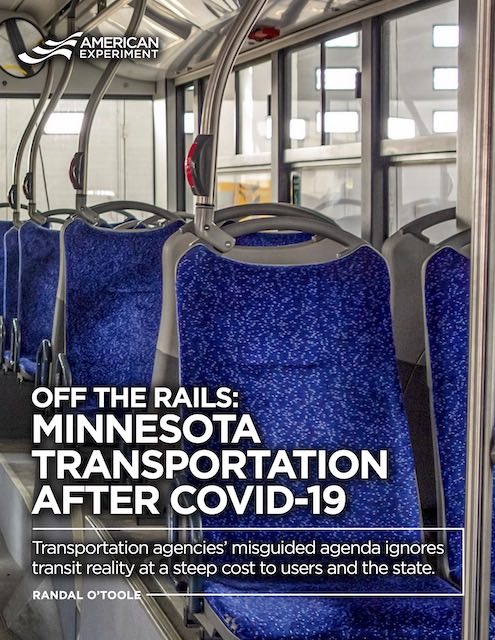Minnesota transportation agencies need to reinvent themselves if they are to survive after the pandemic, according to a new report published yesterday by the Center of the American Experiment, Minnesota’s free-market think tank. Off the Rails: Minnesota Transportation After COVID-19 says that the world has changed so much that any transportation plans written before 2020 will no longer make sense (if they ever did).
 Click image to download a 3.1-MB PDF of this 48-page report.
Click image to download a 3.1-MB PDF of this 48-page report.
In case you can’t read the fine print on the image above, the report was written by yours truly and so all of its themes — increased numbers of telecommuters, the follies of light rail, the importance of funding transport out of user fees, not to mention more than a dozen brightly colored charts — will be familiar to Antiplanner readers. But in some respects, the Twin Cities’ post-pandemic experiences have been more extreme than most.
Downtown Minneapolis has been one of the slowest central business districts to recover from the pandemic, which means telecommuting will remain high and transit ridership low for a long time. Another factor hurting Twin Cities transit is that its light-rail system suffers from far more crime than any other light-rail system in the country, experiencing almost twice as many crimes per billion passenger-miles as the next-highest system and six times the national average for light rail. This is on top of the fact that light rail is just about the most crime-ridden form of transit in the country. (San Francisco’s trolley buses also experience a lot of crime, mainly because it, like light rail, uses an honor system of fare collection.)
For these and other reasons, the report recommends that the region convert the Southwest light-rail line, which is under construction with the usual cost overruns, into a dedicated bus line. This will be less expensive to complete, less expensive to operate, and — should there be any real demand — have a greater capacity to move people than light rail.
In other news, the Federal Transit Administration issued December 2022 transit data yesterday. I’ll post my usual assessment of these monthly data tomorrow.








The chief of Eden Prairie, maybe it’s just coincidence, is planning on retiring before Southwest light rail starts to run in the city.
SWLRT’s decision to build a tunnel for their trains rather then the far, far, far, far cheaper option of rerouting and/or reengineering the existing bike path smacks of some good ol boys giving each other money in a “legal” way.
The gap in crime between Metro Transit LRT and others is crazy. COuldn’t figure out what was diff in MPLS + STPL than any other big central city ( lack of law enforcement, poverty, et al. ). Maybe this isn’t the case but in looking at LRT lines around the country, Metro Transit seems unique in having 2 lines that go through some of the poorest areas of town ( Philips, Powderhorn. Frogtown, etc. ). Other systems as a whole don’t do that.
SWLRT will be different in that sense. On the other hand, the line just runs out into a suburb with nothing around the stations and worse, they all developed. There almost no opportunity for housing + retail short of buying up existing homes and bulldozing them.
BTW – Speaking of buses, did you see that Metro Transit wanted to run the proposed Purple BRT line to downtown White Bear Lake? There was local opposition and they dropped it.
It was the sort of destination for the numerically challenged. It’s really downtown in name, where a couple blocks. Most of the catchment area is empty ( mostly White Bear Lake itself ).
Hopefully they’ll change it to the near by community college. That would give the school a robust link to the minihub at Maplewood Mall.